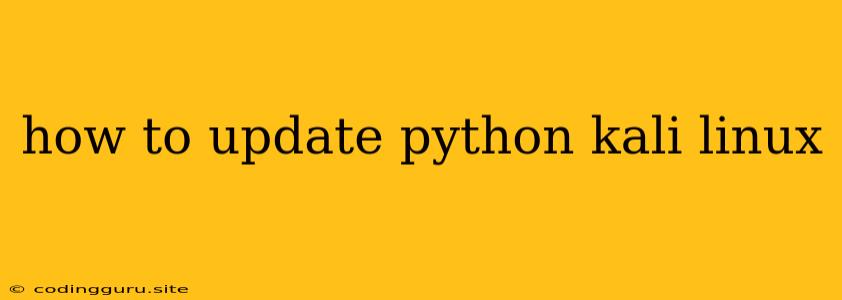How to Update Python on Kali Linux: A Comprehensive Guide
Keeping your software up-to-date is crucial for security, performance, and access to the latest features. This is especially true for Python, a popular programming language used in countless applications. Kali Linux, a Debian-based distribution specifically designed for penetration testing and security auditing, relies heavily on Python for many of its tools. This guide will walk you through the process of updating Python on your Kali Linux system.
Why Update Python?
- Security Patches: Updates often include fixes for security vulnerabilities, protecting your system from malicious attacks.
- New Features and Enhancements: Newer versions of Python may introduce new features, improvements, and bug fixes that enhance your coding experience.
- Compatibility: Updating Python can ensure compatibility with the latest libraries and frameworks, preventing compatibility issues and errors.
Understanding Python Versions
Kali Linux typically comes pre-installed with multiple Python versions, most commonly Python 2 and Python 3. It's important to note that Python 2 is considered legacy and is no longer actively supported. Python 3 is the recommended and actively developed version. While Python 2 may still be used by some tools or scripts, it's best practice to favor Python 3 for new projects and development.
Methods for Updating Python
There are two main methods for updating Python on Kali Linux:
-
Using the Package Manager: Kali Linux utilizes the
aptpackage manager for installing and updating software. This is the easiest and most recommended approach. -
Compiling from Source: While more advanced, compiling Python from source gives you greater control over customization and specific versions.
Updating Python Using the apt Package Manager
-
Update the Package List: First, ensure your package list is up-to-date:
sudo apt update -
Install the
python3-pipPackage: Thepippackage manager is essential for installing and managing Python packages.sudo apt install python3-pip -
Upgrade Python 3: This command upgrades Python 3 to the latest available version in the Kali Linux repositories.
sudo apt upgrade python3 -
Verify the Update: After the upgrade, you can verify the Python version by running:
python3 --version
Updating Python by Compiling from Source
-
Download the Python Source Code: Visit the official Python website and download the source code for the desired Python version.
-
Extract the Source Code: Use
tarto extract the downloaded archive:tar -xf Python-3.x.x.tgz -
Configure Python: Navigate to the extracted directory and run the configure script:
cd Python-3.x.x ./configure -
Compile and Install Python: Compile and install Python:
make sudo make altinstall -
Verify the Update: Verify the newly compiled Python version:
python3 --version
Managing Multiple Python Versions
Kali Linux allows you to have multiple Python versions installed simultaneously. You can use the python command with version numbers to specify which version to use. For example:
python2for Python 2python3for Python 3python3.8for Python 3.8
Important Considerations
- Virtual Environments: It's highly recommended to use virtual environments to isolate projects and prevent dependency conflicts. Virtual environments allow you to create separate Python environments for each project, ensuring that different projects don't interfere with each other.
- Third-party Libraries: After updating Python, ensure you update any third-party libraries that you use.
- Script Compatibility: If you have existing scripts written for older Python versions, you may need to adjust them to work with the updated version.
Conclusion
Updating Python on Kali Linux is a straightforward process, especially using the apt package manager. Remember to update your package list, install the necessary packages, and then upgrade Python to the latest version. Updating Python regularly is crucial for maintaining a secure, functional, and efficient development environment.
